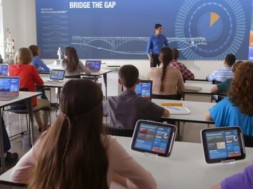The effectiveness of technology use in the classroom has become a controversial issue. While many teachers and students feel that it’s best to use technology because it enhances teaching many others feel that it causes too many challenges and that it is a waste of time. If technology is as effective in the classroom as many teachers believe it to be; why do some students dislike it so much?
In order to objectively respond to this question, 3 articles were examined. 2 out of the 3 relate how the use of technology in the classroom frustrates students while the last one translates the thoughts of students who feel that technology in the classroom has responded to their need. So the issue is not that technology is not effective but rather that some teachers need to be mindful about technology use in the classroom and others need to be trained in order to properly use technology to teach so that students do not view technology as obstruction learning but as an enhancing tool.
After summarizing the 3 articles that have been reviewed we will be able to prove that there are 2 groups of students who claim to dislike technology in the classroom: Those who are improperly exposed to it by their teacher and those who did not give themselves enough time to familiarize themselves with it. We will then be able to get to the logical conclusion that those same students would appreciate the value of technology in the classroom if their teachers used it properly. Let us first summarize the articles that we are referring to.
The article “When good technology means bad teaching related that many students feel that teachers and professor use technology as a way to show off. Students complain of technology making their teachers “less effective than they would be if they stuck to a lecture at the chalkboard” (Young) other problems related by students include teachers wasting class time to teach about a web tool or to flab with a projector or software. When teachers are unfamiliar with the technological tools, they are likely to waist more time trying to use them the technological software that is used the most according to students is PowerPoint. Students complain that teachers use it instead of their lesson plan. Many students explain that it makes understanding more difficult “I call it PowerPoint abuse” (Young). Professors also post their PowerPoint Presentation to the school board before and after class and this encourages students to miss more classes.
Another problem reported in the article with the use of technology in the classrooms is that many schools spend time to train their staff about how to use a particular technology but it does not train them on “strategies to use them well” (Young). The writer believed that schools should also give small monetary incentives to teachers and professors to attend workshops.
In an interview made with 13 students, “some gave their teacher a failing when it came to using Power Point, Course Management systems and other classroom technology” (Young ) some of the complains were again about the misuse of PowerPoint’s and the fact that instructors use it to recite what’s on the scale. Another complaint was that teachers who are unfamiliar with technology often waste class time as they spend more time troubleshooting than teaching. The last complain mentioned is that some teachers require students to comment on online chat rooms weekly but that they do not monitor the outcome or never make reference to the discussion in class.
Similarly, the article “I’m not a computer person” (Lohnes 2013) speaks to the fact that students expectations as far as technology is concerned is very different. In a study done with 34 undergraduate university students, they advise that technology is an integral part of a university students life because they have to do must everything online from applying for college or university, searching and registering for classes, pay tuition and that in addition to being integrated in the administration, etc. technology is also widely used to teach and is valued by higher education.
Those students, however, feel that technology poses a barrier to success as they struggle to align with the ways in which the institution values technology.” A student explains that technology is used in her freshman year to turn in assignments, participate in discussion boards and blogs, emailing the professor, viewing grades and for a wide range of other administrative task including tracking the next school bus. This particular student whose name is Nichole says that she does not own a laptop but shares a family computer. She has a younger brother who also uses the computer to complete his school work so she consequently has to stay up late to complete assignments. She states “technology and I? We never had that connection” (Lohnes). Nichole dislikes the fact that her college requests that she had more contact with technology than she is conformable with. Nonetheless, she explains that as she started doing those school online assignments so frequently she came to realize that they were not that bad.
One of her issues though with technology is that she had come from Puerto Rico about a year prior entering college and that she never had to use the computer so much there. The articles relates that other college students like Nichole have admitted that they are “reluctant technology users” (Lohnes) The article wants to explain, in essence, that although most people would expect that college students prefer technology and are already familiar with it,” that assumption is faulty” (Lohnes).
On the other hand, the article “What Screenagers Say About… ” High school age students were asked about what they thought of technology but most expressed liking it. One of them said about PowerPoint: “My history teacher did a good job with Power Points. He would put them online, which made for really great reviews.” (Screneagers, 2011) Others expressed how technology was really who they are and that teachers should understand for example that when they text in class, they are not being rude but that they have gotten used to multi tasking. Another student invites teachers to not be afraid of technology “Teachers shouldn’t be afraid of technology. Understand that it’s how we live our lives. So don’t just push it out. Learn to cope with us and how we work.” (Screenagers, 2011)
Another student however, expressed how she prefers simpler technology that her teacher is comfortable with rather than high tech that the teacher does not manipulate well “The most important thing for teachers is to be comfortable with what they’re using. It doesn’t have to be super high tech. My math teacher used a projector, and it was one of my favorite classes. Then I would go to this other class where the teacher used Power Points and the SMART board, but I didn’t get any more out of it because she wasn’t comfortable with the technology” (Screenagers, 2011) Students spoke about their appreciation for virtually all types of technology used in the classroom. Another said “One of my teachers used Skype. That’s face-to-face interaction. If I had a problem with some math problem I was working on, I could take a picture of it and put it on the Skype screen. She could see where I was making my mistake. It really helped.” (Screenagers, 2011) The bottom line is that those high school students wanted to let teachers know that they really like technology and that it is already a great part of their daily routine but that it had to be used properly in order for them to enjoy it.
Similarly, they summarize a few things that they dislike as well. Among the list, they said: reading on the computer, paying a lot for an online textbook and the fact that they often forget everything else when they get caught up with using technology.
Nonetheless, they had much more positive things they liked in technology like for example that some teachers would text a question for them to think about before class, so if they do not know they answer, they would communicate with classmates to discuss the possibility for the answer before class. This allows them to go to class prepared. They also like using Skype, emailing their teachers instead of going to speak to them in person. They also enjoy discussion boards. The advice they would like to convey to their teachers is to make sure that they are comfortable with whatever technological tools they are using, to give them more freedom to use the good sites and those in the middle range when they are surfing the net using school computers and to understand that technology is part of their lives.
After summarizing those articles, we can see that the students mentioned in Youngs, 2004 dislike technology because their experience with it was not satisfactory. In other terms, a group of students dislike technology because some teachers are not mindful about technology use or they need additional training. For example, some students are frustrated because they feel that instructors waist their time when they are not properly trained to use the technological tools. Others disliked the fact that some teachers had PowerPoint presentations which were either not meaningful or they would just read whatever they wrote and add no additional comments. Those examples are called “bad teaching (Young, 2004) and they are in fact terrible examples that teachers should not follow because technology is not meant to help teachers do the least work or to adopt poor teaching practices. Somme students related that PowerPoint was widely used by teachers so they even call it PowerPoint abuse.
I can relate to what is being expressed by those students. I observed a Teaching Assistant teach a grammar class recently. He purchased a device to allow him to monitor the screen without touching the computer. He was able to walk throughout the class while changing slides. It all looked so impressive but despite all of this show, students were left so confused at the end of the lesson. When they asked questions, he went back to the slide that had the grammar rule and read it over to the class. The PowerPoint was a duplication of the textbook chapter. The same examples of the book were used. At the end of the course, he felt that he had done a great PowerPoint when in fact, it was not meaningful. It was a copy/paste project from the text book to the screen. This example shows that we need to use common sense when using technology. When teaching grammar, a teacher has to be able to come up with examples other than those in the book, you have to write on the board, have student practice what they have learned. PowerPoint use was a real bad idea, in my opinion, for teaching this course. It was just not the right technological tool for the lesson.
Students in that class may decide that they hate Power Points because it confuses them more while the issue is not with the use of PowerPoint but instead with the teacher’s poor choice of technology. The point I also want to make here is that teachers may sometimes be unaware of their improper use of technology. This is why, as educators, we sometimes need to ask students for their feedback so we may make corrections where needed.
We can then conclude that those students dislike technology as a result of improper technological use by teachers, and also because many teachers do not attend workshops or training sessions to help them obtain a broader knowledge of technology since they are so busy. Like suggest (Youngs, 2004) and (Lohnes, 2012), those same busy teachers would have attended those trainings if there were given an incentive. In the article “Technology Standards in a Third-Grade Classroom” (Kovalik, 2001), it is related how a study done on a 3rd grade class of 25 showed that students were properly using technology. There is no indication that those students dislike using technology. The article also mentioned how the teachers were highly trained because the Ohio board pays incentive to teachers to participate in technology training which teaching them not only how to use technology by teaches them strategies on when to use them.
Boards from other states should consider doing the same thing to ensure that their teachers are responding to the technological need of their students and that they are teaching them according to the standards. The Ohio school mentioned above met the standards as far as technology is concerned because of the technology coaching received by the teachers. If teachers learn how to properly use technology in the classroom, it will be a less frustrating experience for them and for the student who will less likely dislike technology since it will meet its purpose to enhance teaching.
The other groups of students who dislike technology are those who were not exposed to it for long enough. The College Freshman, Nichole advises that she was not exposed to so much technology while she was in high school in her home country; consequently, it seemed to be a burden to her to have to need a computer to complete most of her school assignments but also to interact with her classmate via a discussion board. What is interesting though is that even though she claimed to dislike technology so much, she advised that once she started to spend so much time using it, she realizes that it is not so bad. Even though it is likely that some people do not like the telephone and texting so much, the computer and some website have become part of most people daily routine. In Nichole’s case, she does not own a laptop and has to wait for her turn to use the family computer which means that she has no attachment to this media because her use of it is controlled. However, once she gets to own her own computer, it is a guaranteed that her view of technology will change.
I returned to school after about 12 years. When I was in college the 1st time around, nothing was electronic but when I contacted USF to apply, they told me that everything was online. At first, I asked why everything was online but once I got used to it, I started to understand the value of having the convenience to do a lot of things without having to live my home.
Therefore, Nichole will certainly not continue to dislike technology that much once she gets more familiar and more attached to it. The fact is that she stated that she started to realize that it was not that bad once she started doing so many assignments. She came to the conclusion that the computer was not yet a friend but that it was no longer an enemy; it became to her an acquaintance.
With this understanding, depending on the background of some ELL students and depending on whether or not they were exposed to technology in their home country, they may not like technology at first but this should not be a sign that they will never come to appreciated it. As teacher, we will need to allow them time to familiarize themselves with it while we continue to properly use it so that we do not advocate against it or involuntary send missed information about its true value.
On the other hand, the last article testifies to the fact that the new generation is technology driven and that when used properly, they benefits from it in the classroom, there are several examples of how teachers originally used technology to teach which are appreciated by students. What should the conclusion be then?
We have proven that technology use is effective in the classroom but that teachers need to take some actions in order to make this tool useful to students. It is necessary that they received some training if they lack it, and like a student suggested in the Screenager article, they should refrain from using complicated tools if they are not sure about how to use them. It’s best to properly use something much simpler that they are familiar with like a high school student suggested.
In addition, it is important for teachers to screen the countless technological tools and to research them before introducing them to their teaching. Should they test some that do not work well, they have to stop using them and seek one that is more appropriate. Most importantly, technology is not always the answer this is why teachers should be balanced when using it. If it is required that we use the board and chalks to help students better understand, this is what we should do. Doing so, we will ensure that more students appreciate the use of technology in the classroom for what it is worth.
Article Source: http://EzineArticles.com/8057926





